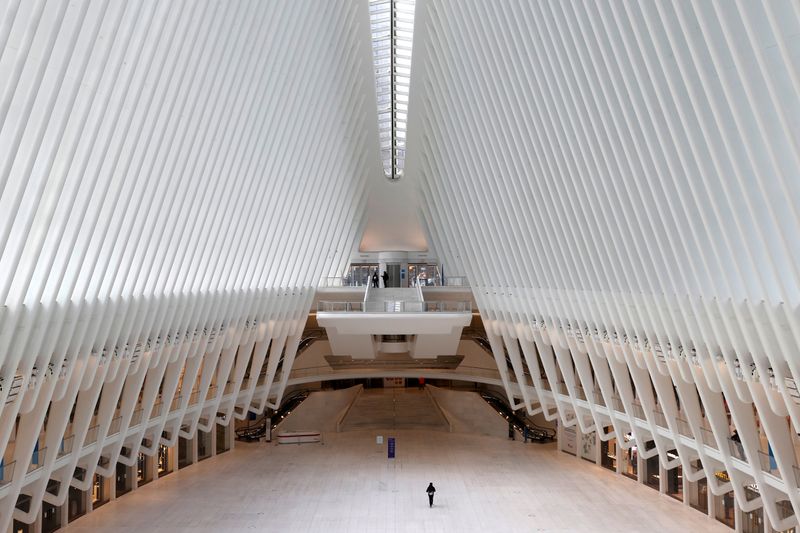
WASHINGTON, March 28 (Reuters) – It may, as House Majority Leader and Maryland Democrat Steny Hoyer said on Friday, be out of love that the United States agreed to shut down much of its economy to stop a viral epidemic and save lives.
It may, as Treasury Secretary Steven Mnuchin said, be out of necessity that the federal government agreed to foot the bill.
Whatever the motivation, in the scope of two frantic weeks, U.S. elected officials and central bankers have engineered an economic intervention unparalleled outside of wartime.
All in it would supplant perhaps 30% of gross domestic product with government spending and loans, drive the federal deficit as high as needed to make that happen, and broaden U.S. social spending in ways that just a few weeks ago Republicans and President Donald Trump were branding as “socialist.”
After Congress delivered final approval following a week of negotiation, Trump on Friday signed legislation that would authorize more than $2 trillion in direct payments to households, loans to small and large companies, and funding that the Federal Reserve may leverage into as much as $4 trillion more in credit – money that will leave a deep government imprint on a pre-crisis economy of $21 trillion.
That has happened with striking speed and, in a country known for its paralyzed and polarized politics, remarkably little haggling over either the moral qualms liberals often have about bailing out companies, or that conservatives often have about increasing benefits for those out of work.
Confronting an outside enemy that is imperiling both employers and employees, the well-buffered as well as the uninsured, those concerns have fallen away.
“No question that officials and politicians, even Republicans in the Senate, are prepared to abandon old shibboleths like ‘government should keep its hands off the private sector,'” while the crisis is underway, said University of California, Berkeley economics professor Barry Eichengreen.
STATISTICS ‘NOT RELEVANT’
As of Friday the coronavirus had infected more than 100,000 people in the United States, now the world leader in cases of COVID-19, the illness named after the new virus was first identified in China late last year.
Ten of millions will likely face at least a short spell of unemployment – not because business conditions became soft, but because they became dangerous. Epidemiologists have warned that every human interaction increases the risk that the coronavirus spreads uncontrolled.
“Economic statistics, at the moment, are not relevant. We’re in an unprecedented situation,” Mnuchin said on Thursday, making what has now become a broadly understood point: The current economic turmoil is by design.
No doubt there will be second-guessing in the months ahead.
“There will be plenty of soul searching,” once the crisis is past, Eichengreen said. “Attitudes about the appropriate role for government are going to be contested even more than was the case.”
There has been little concern about the annual government deficit, for example, even though Fed officials have said it could top the 90% of gross domestic product level some academics view as a “red line” for trouble.
Similarly, there may be a reckoning over how the world’s largest economy can spend roughly 18% of its annual output on health care and be short of basic tools.
“Why can’t the greatest economy in the history of the world produce swabs, face masks and ventilators in adequate supply?,” former Treasury Secretary Lawrence Summers said on Twitter last week.
A NEW NORMAL AHEAD
Just as the financial crisis a decade ago reinvented the rules for banking, the coronavirus pandemic too may prompt its own stripe of fundamental economic change.
The Fed spent a decade laying plans to “normalize” monetary policy after the 2007 to 2009 crisis. For a brief time it even raised interest rates and shed some of the trillions of dollars in bonds it had bought to support the economy.
Interest rates are back to zero, and the Fed has restarted bond buying. The central bank’s asset holdings topped a record $5 trillion this week, and could be on pace to even double that, perhaps hitting a level equivalent to 50% of GDP or more.
A decade ago, as the Fed expanded its role in markets and the economy, there was widespread fretting about the risks involved: financial instability, inflation, or just the propriety of a central bank owning so much.
But the list of assets has now expanded, in effect to include the bonds of private corporations.
No one’s complaining.
“The only chance we have to prevent our health care system from being overwhelmed is for as many Americans to stay home as possible,” Hoyer said as the House opened debate on the bill Friday morning. “We are keeping a distance not out of hostility … but out of love.”
Source: Economy - investing.com



